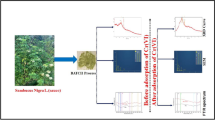Summary
Chromium(III), Cr(III) adsorption capacities of the leaves of 34 conifer species were examined. Among these, Ginkgo biloba, Taxus cuspidata, Cephalotaxus harringtonia var. nana, and Taxodiaceae and Cupressaceae spp. showed large capacities to adsorb Cr(III). The adsorption capacities of conifer leaves for Cr(III) (3.12–5.09 mg Cr g−1 adsorbent) compared favorably with those of commercial activated carbons (1.23–2.75 mg g−1). Factors affecting Cr(III) adsorption were studied using G. biloba leaves. The factors included solution pH, contact time, temperature, and the initial concentration of Cr(III). The amount of Cr(III) adsorbed on the adsorbent increased steadily with increasing pH in a pH range from 2 to 5, with increasing contact time, and with increasing temperature ranging 20 to 40 °C. The Cr(III) adsorption was also affected by the initial concentration of Cr(III) in the solution. A linear relationship was observed between the amount of Cr(III) adsorbed and the equilibrium concentration of Cr(III) in the solution when graphed logarithmically. The maximum capacity of G. biloba leaves was 27.5 mg Cr g−1 adsorbent by column experiments.
Similar content being viewed by others
Author information
Authors and Affiliations
Additional information
Received 13 January 1998
Rights and permissions
About this article
Cite this article
Aoyama, M., Tsuda, M., Cho, NS. et al. Adsorption of trivalent chromium from dilute solution by conifer leaves. Wood Science and Technology 34, 55–63 (2000). https://doi.org/10.1007/s002260050008
Issue Date:
DOI: https://doi.org/10.1007/s002260050008




